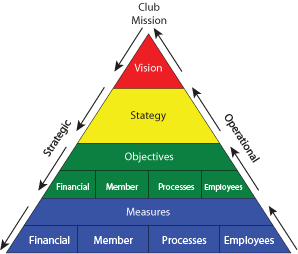The Problem: The right strategy is critical in today's challenging club industry, with its need to satisfy the diverse expectations of new and existing members. Studies suggest that fewer than 20 percent of
organizations execute strategies they develop, and the vast majority of employees do not understand the organization's strategy. While the development of a winning strategy has never been simple, successful
execution is considerably more daunting.
There are four common reasons for a club's poor execution of strategy:
The Need: To overcome the common barriers to strategy execution, clubs need organizational and
department-specific metrics and performance indicators that transform big picture strategies into a
time-specific, multi-year operational plan. Analysis of such metrics enables management to closely monitor the execution progress on a departmental level and reveal when quick corrective action is needed to deal with changes or delays.
The Solution: The Balanced Scorecard is a business process and tool that enables management to effectively implement a club's strategic plan – through the translation of its mission, vision, values, and strategy – into language that motivates performance and ensures a shared comprehension of the organization's goals. It uses an instrument panel of carefully selected lag and leading indicators derived from a club's strategic plan.
Executing strategy is both a 'top-down' (strategic) and 'bottom-up' (operational) process.
Top-Down: The club's strategic plan emanates from the mission, vision, and directional strategies to achieve the club's five-year financial and membership growth goals. The plan focuses on business processes, programs, as well as the employee skills and abilities needed to achieve the goals.
Bottom-Up: The GM and department managers transform the strategic plan goals and objectives into measurable department and staff-specific performance plans. They include clearly defined key performance indicators that frame the needed processes, as well as the employee skills and competencies to achieve the strategic goals.
Financial indicators are critical to the sustainability of every club, but for the purposes of an operational plan they lack predictive power, often reinforce isolated functions, and are not relevant to many levels within the club. Commonly, lag indicators such as F&B covers, golf rounds, and average spending per member are inadequate to define the process that produces them. Indicators of intangible membership value that 'lead' to the financial and usage indicators are, for example, exceptional recreational and dining experiences that result in valuable social experiences. Examples of independent variables that contribute to these are food quality, staff knowledge, skills, and service quality standards. These are more meaningful 'lead' indicators that frame measurable operational department plans and results.
The Balanced Scorecard integrates the integrity of financial numbers required for club sustainability and growth, with drivers of future success. It enforces a discipline around strategy execution by challenging management to carefully translate department strategies into objectives, measures, targets, and actions in four perspectives: Financial Indicators, Membership Value, Operational Processes, and Employee Skills and Ability.
A well-crafted Balanced Scorecard transforms the strategic plan into operational goals, metrics, investments in staff development, and manager accountability for specific results within the specified timeframes. The scorecard gives the board, general manager, and department managers a definitive ability to tell the story of the club's strategy through a series of cause-and-effect linkages inherent in the scorecard measures. It also creates a standard method for all participants to communicate in a common language.
The relationships are revealed through a series of 'if-then' statements. For example, "If we are to achieve our revenue goals, then we will need to improve the value of our dining experience through improved food quality and staff service to compete with outside restaurants." "If we are to improve our staff service, then we must implement a more comprehensive staff training program with performance incentives." The linkage between staff improvement (service), food quality (product), and member usage of the club's F&B amenity (value) leads to the club's financial goals. This process results in the department operational plans and key individual performance indicators required to achieve department goals that contribute to the execution of the club's strategy. It breaks down departmental silos of data and information, which become part of the total team understanding of each department's role, responsibility, and how they collectively contribute to the club's operational success.
Explicitly documenting the assumptions in the club strategy through a cause-and-effect network of measures greatly enhances the opportunities for strategic effectiveness at the senior management level and makes for efficient monitoring at the board level.


For a request for proposal or additional information,
please CONTACT us.
Call or email Roger Hietbrink directly:
Office: 904-373-0314
Mobile: 904-607-7330
rhietbrink@gmail.com
